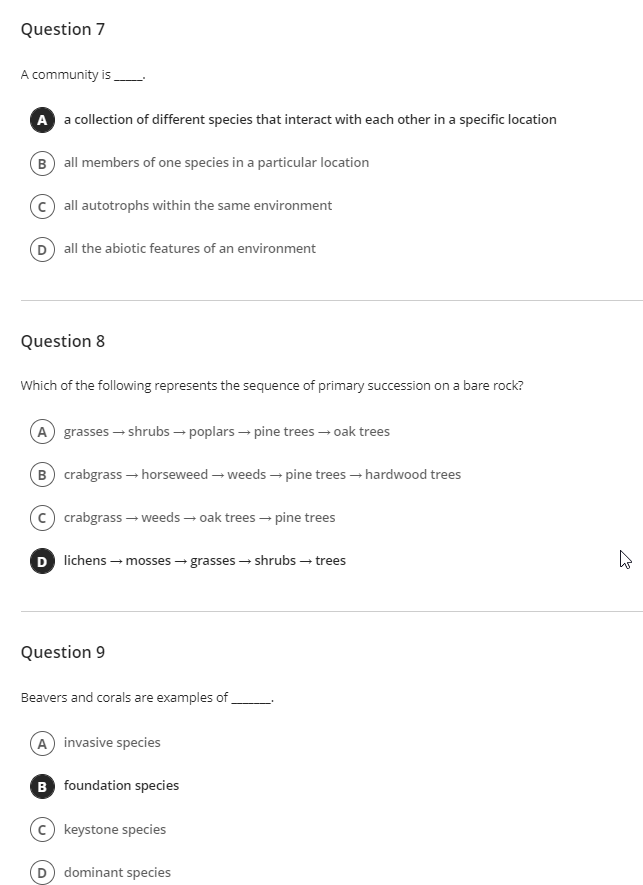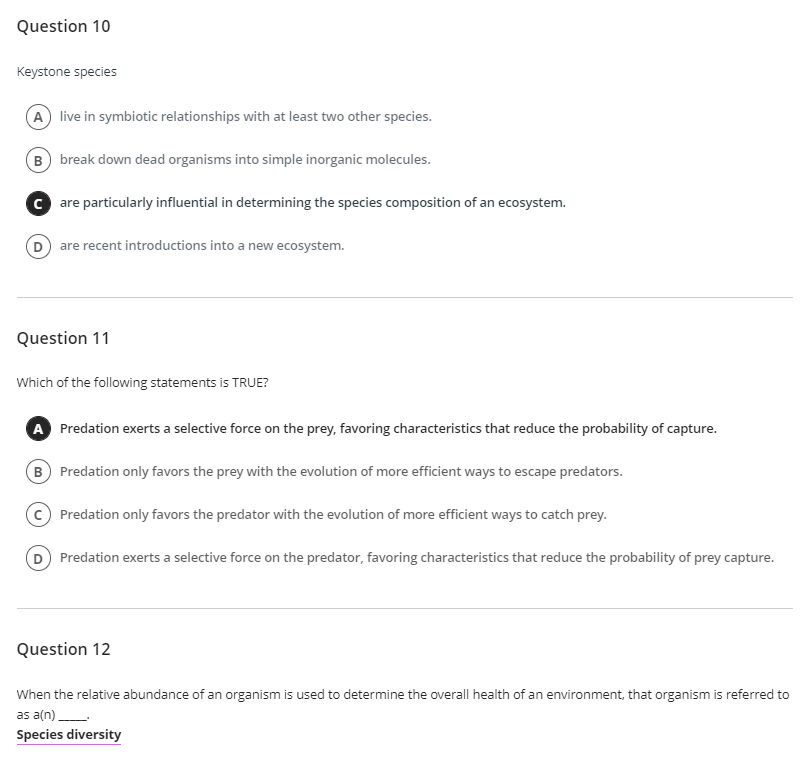Question 7 A community is_ A a collection of different species that interact with each other in a specific location Ball members of one species in a particular location all autotrophs within the same environment D all the abiotic features of an environment Question 8 Which of the following represents the sequence of primary succession on a bare rock? A grasses - shrubs → poplars – pine trees - oak trees B crabgrass - horseweed - weeds – pine trees – hardwood trees crabgrass – weeds – oak trees - pine trees D lichens – mosses - grasses – shrubs – trees Question 9 Beavers and corals are examples of A invasive species B foundation species keystone species dominant species
Question 7 A community is_ A a collection of different species that interact with each other in a specific location Ball members of one species in a particular location all autotrophs within the same environment D all the abiotic features of an environment Question 8 Which of the following represents the sequence of primary succession on a bare rock? A grasses - shrubs → poplars – pine trees - oak trees B crabgrass - horseweed - weeds – pine trees – hardwood trees crabgrass – weeds – oak trees - pine trees D lichens – mosses - grasses – shrubs – trees Question 9 Beavers and corals are examples of A invasive species B foundation species keystone species dominant species
Human Anatomy & Physiology (11th Edition)
11th Edition
ISBN:9780134580999
Author:Elaine N. Marieb, Katja N. Hoehn
Publisher:Elaine N. Marieb, Katja N. Hoehn
Chapter1: The Human Body: An Orientation
Section: Chapter Questions
Problem 1RQ: The correct sequence of levels forming the structural hierarchy is A. (a) organ, organ system,...
Related questions
Question

Transcribed Image Text:Question 7
A community is
A a collection of different species that interact with each other in a specific location
B) all members of one species in a particular location
all autotrophs within the same environment
D all the abiotic features of an environment
Question 8
Which of the following represents the sequence of primary succession on a bare rock?
A grasses – shrubs → poplars - pine trees – oak trees
B crabgrass – horseweed – weeds → pine trees – hardwood trees
c) crabgrass – weeds – oak trees – pine trees
D lichens – mosses - grasses – shrubs – trees
Question 9
Beavers and corals are examples of
A invasive species
B foundation species
keystone species
dominant species

Transcribed Image Text:Question 10
Keystone species
A live in symbiotic relationships with at least two other species.
B break down dead organisms into simple inorganic molecules.
C are particularly influential in determining the species composition of an ecosystem.
are recent introductions into a new ecosystem.
Question 11
Which of the following statements is TRUE?
A Predation exerts a selective force on the prey, favoring characteristics that reduce the probability of capture.
B Predation only favors the prey with the evolution of more efficient ways to escape predators.
Predation only favors the predator with the evolution of more efficient ways to catch prey.
D Predation exerts a selective force on the predator, favoring characteristics that reduce the probability of prey capture.
Question 12
When the relative abundance of an organism is used to determine the overall health of an environment, that organism is referred to
as a(n)
Species diversity
Expert Solution
This question has been solved!
Explore an expertly crafted, step-by-step solution for a thorough understanding of key concepts.
This is a popular solution!
Trending now
This is a popular solution!
Step by step
Solved in 2 steps

Knowledge Booster
Learn more about
Need a deep-dive on the concept behind this application? Look no further. Learn more about this topic, biology and related others by exploring similar questions and additional content below.Recommended textbooks for you

Human Anatomy & Physiology (11th Edition)
Biology
ISBN:
9780134580999
Author:
Elaine N. Marieb, Katja N. Hoehn
Publisher:
PEARSON

Biology 2e
Biology
ISBN:
9781947172517
Author:
Matthew Douglas, Jung Choi, Mary Ann Clark
Publisher:
OpenStax

Anatomy & Physiology
Biology
ISBN:
9781259398629
Author:
McKinley, Michael P., O'loughlin, Valerie Dean, Bidle, Theresa Stouter
Publisher:
Mcgraw Hill Education,

Human Anatomy & Physiology (11th Edition)
Biology
ISBN:
9780134580999
Author:
Elaine N. Marieb, Katja N. Hoehn
Publisher:
PEARSON

Biology 2e
Biology
ISBN:
9781947172517
Author:
Matthew Douglas, Jung Choi, Mary Ann Clark
Publisher:
OpenStax

Anatomy & Physiology
Biology
ISBN:
9781259398629
Author:
McKinley, Michael P., O'loughlin, Valerie Dean, Bidle, Theresa Stouter
Publisher:
Mcgraw Hill Education,

Molecular Biology of the Cell (Sixth Edition)
Biology
ISBN:
9780815344322
Author:
Bruce Alberts, Alexander D. Johnson, Julian Lewis, David Morgan, Martin Raff, Keith Roberts, Peter Walter
Publisher:
W. W. Norton & Company

Laboratory Manual For Human Anatomy & Physiology
Biology
ISBN:
9781260159363
Author:
Martin, Terry R., Prentice-craver, Cynthia
Publisher:
McGraw-Hill Publishing Co.

Inquiry Into Life (16th Edition)
Biology
ISBN:
9781260231700
Author:
Sylvia S. Mader, Michael Windelspecht
Publisher:
McGraw Hill Education